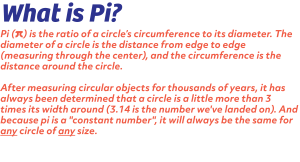
Pi Day is celebrated on March 14th (3/14) around the world. Pi (Greek letter “π”) is the symbol used in mathematics to represent a constant — the ratio of the circumference of a circle to its diameter — which is approximately 3.14159. Pi Day is an annual opportunity for math enthusiasts to recite the infinite digits of Pi, talk to their friends about math, and eat pie.
Pi has been calculated to over 50 trillion digits beyond its decimal point. As an irrational and transcendental number, it will continue infinitely without repetition or pattern. While only a handful of digits are needed for typical calculations, pi’s infinite nature makes it a fun challenge to memorize, and to computationally calculate more and more digits.
Learn More About Pi – What is Pi?
Who is the official sponsor of Pi Day?
Mometrix is a test preparation company that has created and curated the world’s largest collection of educational materials for helping individuals pass high-stakes standardized tests.
They pride themselves on producing the very best content for exams and certifications across the country. What they care about even more, however, is empowering individuals across the nation to achieve their dreams. In fact, creating “prep that empowers” is in their company’s DNA.
Mometrix’s goal is for their study materials, coupled with diligent effort, to empower a test-taker to attain the highest score within their ability to achieve. Mometrix prepares people to achieve their dreams by helping them overcome the testing hurdles necessary for them to get where they want to be.


